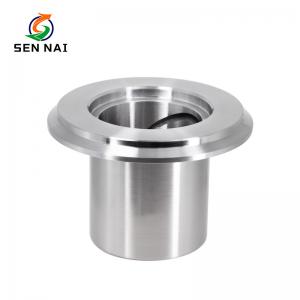
Add to Cart
Factory Direct Supply Farms Temperature Bush Precision High Quality Self-lubricating
Low carbon steel bushings, also known as mild steel bushings, are a type of bushing made from low carbon steel alloy. Low carbon steel contains a relatively low amount of carbon, typically ranging from 0.05% to 0.25%, which makes it softer and more ductile compared to higher carbon steels.
Here are some characteristics and features of low carbon steel bushings:
Ductility: Low carbon steel has excellent ductility, which means it can be easily formed, bent, and machined into various shapes and sizes. This makes it suitable for manufacturing bushings with complex geometries.
Good Machinability: Low carbon steel is known for its good machinability, allowing for easy cutting, drilling, and shaping during the manufacturing process. It can be easily machined to achieve precise dimensions and tolerances.
Moderate Strength: Compared to higher carbon steels, low carbon steel has moderate strength. While it may not be as strong as other steel alloys, it still offers sufficient strength for many applications that do not require high load-bearing capacity.
Weldability: Low carbon steel exhibits good weldability, allowing for easy joining of bushing components through welding or brazing. This feature enables the fabrication of complex assemblies or the repair of existing structures.
Cost-Effective: Low carbon steel is generally more affordable compared to higher carbon steels or other materials like stainless steel or bronze. This cost-effectiveness makes low carbon steel bushings a popular choice for applications where high-performance materials are not necessary.
Corrosion Resistance: Low carbon steel is susceptible to corrosion when exposed to moisture or corrosive environments. Therefore, proper protective coatings or treatments, such as zinc plating or painting, are often applied to enhance its corrosion resistance.

| Performance Index | | Data | |
| Hardness | HRC | 58-62 | |
| Max Load | N/mm2 | 250 | |
| Max Linear Velocity | m/s | 0.1 | |
| Max PV Value | N/mm2.m/s | 1.5 | |
| WorkingTemperature Limit | ℃ | -100~ +350 | |
| Linear Expension Coefficient | 10-5/℃ | 1.1 | |






| Performance Index | | Data | |
| Hardness | HV | ≥650 | |
| Max Load | N/mm2 | 200 | |
| Max Linear Velocity | m/s | 0.1 | |
| Max PV Value | N/mm2.m/s | 1.5 | |
| WorkingTemperature Limit | ℃ | -100~ +350 | |
| Linear Expension Coefficient | 10-5/℃ | 1.1 | |

| Performance Index | | Data | |
| Hardness | HV | ≥650 | |
| Max Load | N/mm2 | 200 | |
| Max Linear Velocity | m/s | 0.1 | |
| Max PV Value | N/mm2.m/s | 1.5 | |
| WorkingTemperature Limit | ℃ | -100~ +350 | |
| Linear Expension Coefficient | 10-5/℃ | 1.1 | |

| Material and bushing characteristics | | value | Company | value | |
| Maximum load | Mpa | 100 | psi | 145,00 | |
| working temperature | ℃ | -40 to 300 | °F | -40 to 572 | |
| Max Linear Velocity | m/s | 0.5 | fpm | 100 | |
| Maximum PV Value | m/sxMPa | 1.65 | pis x fpm | 48,000 | |
| Minimum hardness of sliding layer | HB | 210 | HB | 210 | |
| Minimum hardness of dual parts | HRC | 40 | HRC | 40 | |













